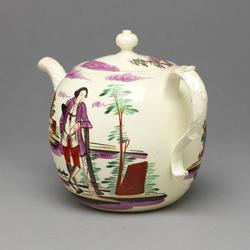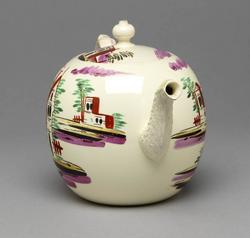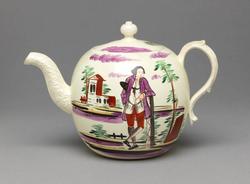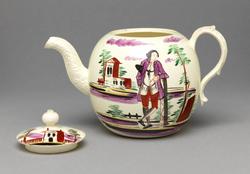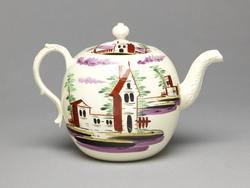Current Location: Gallery 27 (Glaisher)
Maker(s)
Factory:
Wedgwood, Josiah
Decorator:
Rhodes, David
Entities
Categories
Description
Cream-coloured earthenware, painted in green, yellow, pale purple, reddish-brown, and black enamel-colours. The pot has a globular body with moulded overlapping leaf spout and reeded and leaf-moulded handle. The circular, slightly domed cover has a pierced globular knob. One side of the pot is decorated with a gentleman leaning on a post in a landscape with a building on the left; on the other side with two buildings in a landscape; and on the cover with one building between trees.
Notes
History note: Probably from the collection of Sir Victor and Lady Gollancz; Sotheby's, 15 July 1975, Catalogue of Important English Pottery from the Well-Known Collection formed by the late Sir Victor and Lady Gollancz, p. 12, lot 41. Messrs A.F. Allbrook, Essex, from whommpurchased in April 1982 by the donors
Legal notes
Given by Sir Ivor and Lady Batchelor
Measurements and weight
Height: 13.6 cm
Length: 19.6 cm
Acquisition and important dates
Method of acquisition: Given
(1995-01-23)
by
Batchelor, Ivor, Sir and Lady
Dating
18th Century, Late
George III
Circa
1770
CE
-
1775
CE
Note
The shape of this teapot is similar to examples marked Wedgwood. The pot illustrates the style of enamel paintingnfound on much early Wedgwood creamware. It is characteristic of enamelling associated with Robinson and Rhodes, a firm of decorators at Leeds to whom Wedgwood was sending creamware by 1763. In 1768 David Rhodes, moved to London to work at Wedgwood's premises in Great Newport Street, which a year later was transferred to a new decorating studio in Chelsea. This teapot was probably enamelled there, rather than earlier at the Leeds decorating workshop, because the gentleman resembles one on a teapot in Norwich Castle Museum, whch can be dated to 1774 because it bears the inscription 'Success to Sir Charles Holte Esq.', who was elected as MP for Warwickshire in the Parliamentary election in that year. Jasper Robinson continued to decorate at Leeds until 1779.
School or Style
Rococo
People, subjects and objects depicted
Components of the work
Decoration
composed of
enamels
( green, yellow, pale purple, reddish-brown, and black)
Parts
Materials used in production
Lead-glaze
Cream-coloured earthenware
Techniques used in production
Lead-glazing
Throwing
References and bibliographic entries
Related exhibitions
Identification numbers
Accession number: C.1 & A-1995
Primary reference Number: 11838
Old object number: 95
Stable URI
Audit data
Created: Saturday 6 August 2011
Updated: Tuesday 30 April 2024
Last processed: Tuesday 22 July 2025
Associated departments & institutions
Owner or interested party:
The Fitzwilliam Museum
Associated department:
Applied Arts
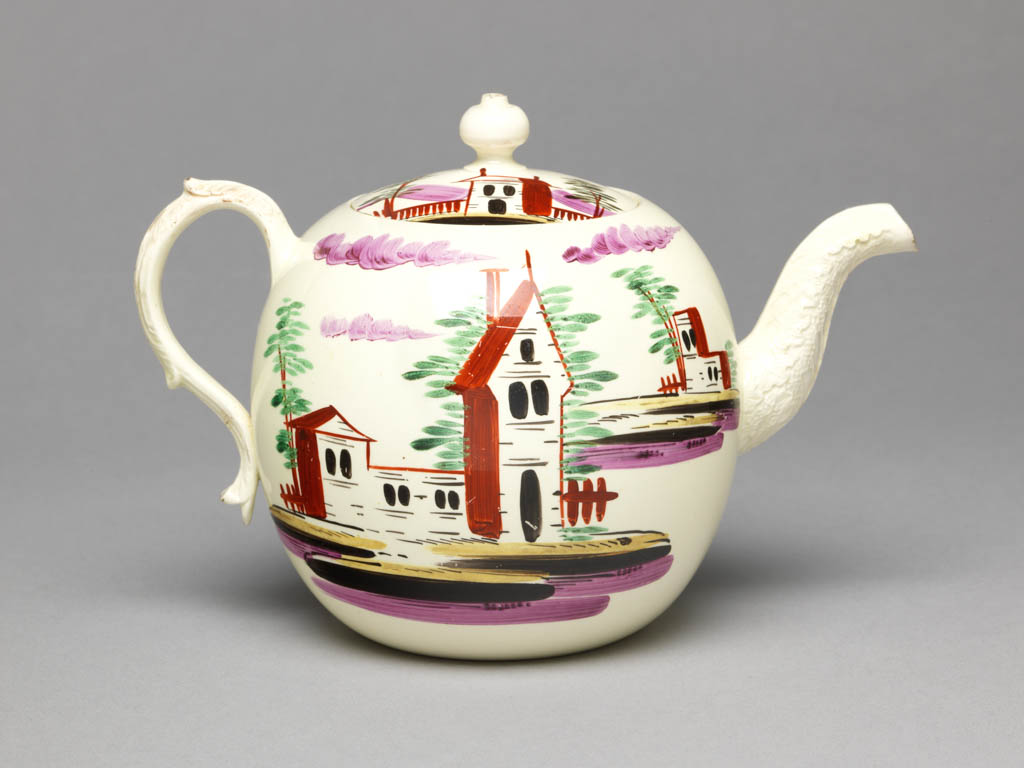
 IIIF Manifest
IIIF Manifest
